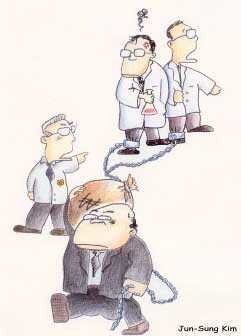Bullies in the lab?
One such issue is academic freedom. Corporate and academic priorities clash when scientists want to share research discoveries, but contracts often require secrecy for 30 to 90 days or longer while patents are weighed.
Betty Dong at the University of California, San Francisco, discovered data that led her to question the effectiveness of a medication being used daily by millions of people. But when she went to report it, she was blocked for seven years by the company that paid for the study.
David Kahn, another researcher at the same school, was sued last November for $10 million by the company that sponsored his study, after he published a report that the AIDS drug he was testing was ineffective.

"They're like bullies in a sandbox who take away their toys when you don't agree with them," Dr. Kahn told The Chronicle of Higher Education.
Few foresaw these clashes two decades ago. Such research partnerships had long been a staple of American higher education, going all the way back to the 1862 federal legislation that created the land-grant university.
But university research started melding with the business world at a much faster pace with the 1980 passage of the Bayh-Dole Act. Bayh-Dole sped up the patenting process for university research, supercharging university-corporate partnerships with profits and competition.
In the 1970s, just a few hundred patents resulted from university research each year. But in fiscal 1999, more than 120 US research universities filed a total of 7,612 patent applications, according to the Association of University Technology Managers. Licenses to industry generated $641 million in gross income for the universities - and about $40 billion in economic activity overall.
"You used to have big corporations with labs that would do their own basic research," Mr. Kiang says. "But ... it's much more effective to turn the universities into R & D labs for them. By sprinkling money around ... they don't have to compete for the best brains in the academic world, they simply buy them at low cost."
The federal government is still by far the dominant funding source for university research. In 1998, corporations were responsible for less than 8 percent of the funding.
That may not sound like much, but it represents a seven-fold growth since 1970. According to the new report, the flood of patents has been a big boost to America's increasingly knowledge-based economy.
Federal Reserve Chairman Alan Greenspan told governors last year: "The payoffs, in terms of the flow of expertise, new products, and startup companies ... have been impressive."
Indeed, for every challenged program like the Novartis-Berkeley union, the Business-Higher Education Forum report documents other collaborations that are working well. At Washington University in St. Louis, for instance, a funding deal with Monsanto (now Pharmacia) has been harmoniously in place for two decades.
Smaller companies have prospered, too. Ribozyme Pharmaceuticals gave the University of Colorado a five-year, $500,000 unrestricted research grant. In return, the university shared research that helped the company grow.
Despite this robust productivity, some fear that a key product of universities - unbiased research - is at risk.
In some fields, especially medical research, scientists complain that corporate cash appears to be undermining the credibility of research results.
In 1996, Tufts researcher Sheldon Krimsky studied nearly 800 scientific papers published in prominent biology and medical journals. In 1 out of 3 cases, he found that a chief author of the paper had a financial interest in the company for which research was being done. In most cases, the connections were not disclosed to readers.
Mildred Cho, a senior research scholar at the Center for Biomedical Ethics at Stanford University, took a different tack. Her 1996 study found that 98 percent of university studies of new drug therapies funded by the pharmaceutical industry reported that those new therapies were more effective than standard drugs. By comparison, just 79 percent of studies without industry financing found the new drugs to be more effective.
Other researchers are disquieted, too.
"There has been in some fields a substantial, industrial-commercial influence," says David Blumenthal, director of Massachusetts General Hospital's Institute for Health Policy and a professor at Harvard Medical School. In a 1998 study, he and colleagues found that 43 percent of scientists - many of them at university medical centers or schools - had received at least one research-related gift. About two-thirds said the gift had been important to their research.
Such conflicts are hardly confined to the medical field. In his 1997 book, "The Heat Is On," Ross Gelbspan cites professors for not disclosing that coal and oil companies had funded their studies, which were used to undercut arguments in favor of reducing greenhouse gases.
Meanwhile, back at Berkeley, the Novartis funding is winning converts. Despite what one university official described as "lingering resentment," only two of 31 faculty members in the Berkeley department have declined to seek grants ranging from $60,000 to $200,000 to fund their research, according to the just issued report.
A need for more disclosure
Will the scientists who do accept corporate funding disclose that information when they publish their research?
Pressure has been building at the federal level for tough new disclosure requirements since the 1999 death of Jesse Gelsinger, a teenage volunteer in the clinical trial of a gene-therapy drug at the University of Pennsylvania. In that case, a researcher had a financial interest in the drug's success. (The death this month of a volunteer in a Johns Hopkins University asthma study is being investigated, but no information has surfaced suggesting any conflict of interest in that federally funded study).
At a meeting last fall, scientists debated whether and how much to disclose about such interests to potential patient volunteers, but could not agree. Researchers receiving federal grants must disclose any income greater than $10,000 from a corporation. But that rule does not apply when companies do all the funding. And even when scientists do report, it is usually only to the university itself, which often does not disclose such financial ties. One ray of hope: The New England Journal of Medicine recently admitted that it had failed to disclose 19 authors' conflicts of interest - and toughened its disclosure policy.
More disclosure at all levels is needed, Dr. Blumenthal argues. The long-term risk, he says, is nothing less than a loss of public confidence that could permanently undermine support for universities.
"There is a need for guidelines and protections to assure the public that commercial motives are not excessive," he says. "It won't be hard to do that if we could get the universities to take the long view.... But in the heat of battle, it's hard to do."
NOTICE: In accordance with Title 17 U.S.C. Section 107, this material is distributed without profit to those who have expressed a prior interest in receiving the included information for research and educational purposes. Feel free to distribute widely but PLEASE acknowledge the original source.


